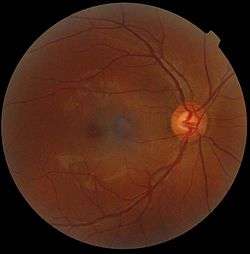Visual artifact

Visual artifacts (also artefacts) are anomalies apparent during visual representation as in digital graphics and other forms of imagery, particularly microscopy.
Examples in digital graphics

- Image quality factors, different types of visual artifacts
- Compression artifacts
- Digital artifacts, visual artifacts resulting from digital image processing
- Noise
- Screen-door effect, also known as fixed-pattern noise (FPN), a visual artifact of digital projection technology
- Distortion
- Silk screen effect
- Rainbow effect
- Screen tearing
- Purple fringing
- Chromatic aberration
- Moiré pattern
- Color banding
Occurrences in video entertainment
Many people who use their computers as a hobby experience artifacting due to a hardware malfunction. The cases can differ but the usual causes are:
- Fan issues, such as failure of cooling fan.
- Unsuited video card drivers.
- Drivers that have values that the graphics card is not suited with.
- Overclocking beyond the capabilities of the particular video card.
The differing cases of visual artifacting can also differ between scheduled task(s).
%2C_an_artefact.jpg)
In microscopy
In microscopy, an artifact is an apparent structural detail that is caused by the processing of the specimen and is thus not a legitimate feature of the specimen. In light microscopy, arteficts may be produced by air bubbles trapped under the slide's cover slip.[1]
In electron microscopy, distortions may be produced in the drying out of the specimen. Staining can cause the appearance of solid chemical deposits that may be seen as structures inside the cell. Different techniques including freeze-fracturing and cell fractionation may be used to overcome the problems of artifacts.[1]
A crush artifact is an artificial elongation and distortion seen in histopathology and cytopathology studies. Distortion can be caused by the slightest compression of tissue and can provide difficulties in diagnosis.[2][3]
References
- 1 2 Kent, Michael (2000). Advanced Biology (Repr. ed.). Oxford: Oxford University Press. p. 64. ISBN 0199141959.
- ↑ Chatterjee, S. (September 2014). "Artefacts in histopathology". Journal of oral and maxillofacial pathology (JOMFP). 18 (Suppl 1): S111–6. doi:10.4103/0973-029X.141346. PMID 25364159.
- ↑ Komanduri S, Swanson G, Keefer L, Jakate S (December 2009). "Use of a new jumbo forceps improves tissue acquisition of Barrett's esophagus surveillance biopsies". Gastrointest. Endosc. 70 (6): 1072–8.e1. doi:10.1016/j.gie.2009.04.009. PMID 19595312.